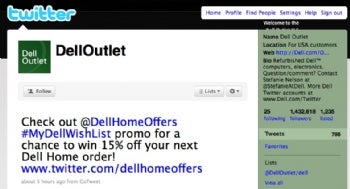Can you tell which of the following tweets is from a small but rapidly growing company?
“One more glass of wine and I will b buying pop tarts from that damn vending machine for dinner, again”
“by the way, ignoring pre existing medical conditions=boon for cancer drug companies. Things r not always wut they appear 2 b”
“2 for 1 tuesday. buy any lrg specialty get medium 1 topping free. $12 value”
The answer: All of the above. The Twitter posts are from Naked Pizza in New Orleans, which serves pizza with 100 percent natural ingredients. As you can tell from the tweets, Naked Pizza uses Twitter to send followers special offers. The company also tweets to converse with customers in a way that mixes humour with social and health consciousness –qualities that reflect Naked Pizza’s brand identity.
So far, Naked Pizza’s social media efforts are paying off, big time. At this moment, just one Naked Pizza exists. By summer 2010, as many as 50 franchises should be open throughout North America, according to cofounder Jeff Leach. He credits Twitter with playing a significant role in the company’s growth.
“If your business doesn’t have anything to tweet about, you’d better shift into a business that does have something to tweet about,” Leach says.
The mandate for small businesses is clear — set up a Twitter account, establish a Facebook page, and start talking. What isn’t always obvious, however, is what you should expect from your social media efforts. Do you need a formal social media strategy? And perhaps the murkiest question of all: How do you measure success?
Social Media: Low Cost, Potentially High Impact
As social networks–especially Twitter and Facebook–grow rapidly, so does the business interest in figuring out how to exploit them.
Twitter had 54.7 million unique visitors worldwide in August 2009, up from 4.3 million in August 2008, according to ComScore. (However, some research suggests that Twitter’s popularity surge has weakened.)
Currently, Facebook has more than 300 million active users. Some 50 million people joined Facebook between July and September 2009 alone.
According to Nielsen Online, the average Facebook user spent 5 hours, 46 minutes on the site in August 2009, far exceeding the average for the number-two online time-drain, Yahoo, at 3 hours, 14 minutes.
Marketers are turning to social media as a low-cost, potentially high-impact way to promote products and services. So far in 2009, 66 percent of marketers used social media in some form, according to the Association of National Advertisers. That’s up from just 20 percent in 2007.
Judging from that data, you’d think small businesses everywhere were fired up about social media. At the moment, that’s apparently not the case, according to a recent Citibank survey of 500 U.S. small businesses (consisting of 100 employees or less). The survey shows that 75 percent of small-business executives aren’t using social media for business. They’re hyperfocused on generating sales and managing cash flow to survive the recession, so things like social media outreach have fallen down the to-do list.
Nevertheless, small businesses that engage with customers on social networks can reap some rewards. First, however, you must set your expectations properly.
Setting Your Social Media Expectations
“It’s unrealistic to think that because you join a social network, your entire business will change,” says Ben Parr, coeditor of Mashable, a leading social media blog. “You have to find people who are interested in what you do and respond to those who are talking about your brand. It should be an ongoing part of the marketing you do. And like anything worth doing, developing your social media profile takes time.”
Once you amass a sizable, loyal following for your Facebook updates and your tweets, you might expect to experience a number of benefits.
Reduced ad spending:
Stanya Doty, the sole proprietor of wine and gift shop Simple Indulgences, says that Facebook and the e-mail campaign service Constant Contact have allowed her to cut ad spending by 75 percent. She admits that getting attention on Facebook can be difficult–but her Facebook fan base is growing. “And if I can get information out without having to pay for it,” Doty adds, “that can only help my business, especially in a difficult economic environment.”
Enhanced customer service and customer relations:
“One negative blog post or tweet about your company can cause a lot of damage,” says Parr. But you can turn it around by responding quickly to the complaint. Cable TV giant Comcast is the gold standard for companies that use social media to respond to their customers. When Comcast gets wind of a complaint about its service on Twitter, the company will usually respond right away to the customer, asking how it can be of help.
Valuable market research:
Chris Lindland, founder of the quirky online-only apparel company Cordarounds, tracks what people are chatting about by using Twitter, viewing Google Alerts, and reading blogs. The blog and Twitter conversations sometimes inspire new Cordarounds products.

For example, Lindland knew from reading blogs and Twitter posts that a lot of active bloggers and tweeters are bicyclists. So Cordarounds developed Bike to Work pants, which have a reflective lining that, when the wearer rolls the cuffs up, provide nighttime safety. Cordarounds got the word out about the new pants through Facebook, Twitter, and e-mail sent to customers and journalists. Almost immediately, Boing Boing and Gizmodo blogged about the pants, Lindland says, and bikers were soon tweeting about them.
“Within a few weeks, we’d sold 500 pairs,” he adds. “It was the greatest impact we’ve had so far in the shortest amount of time.”
Lindland also tracks conversations on Twitter and in the blogosphere after a product launches, to get feedback. Cordarounds responds directly to many tweets, but always in a way that’s personal and–in keeping with its brand–offbeat, Lindland says.
Improved search engine optimization:
When you’re creating buzz on social media networks, chances are high that bloggers, journalists, and other parties will link to your Web site. External links pointing to your site–especially those from authoritative, relevant, and highly trafficked sites–can boost your site’s ranking in Google and other search engines, says Adam Lasnik, Google’s search evangelist. “Those links tell Google your Web page is likely more relevant and more important than others [without similar-quality links],” he says.
The ability to tell customers where to find you:
A number of small, itinerant food businesses are successfully using Twitter and other social media to let customers know their locations. Curtis Kimball, who operates a mobile crème brûlée cart in San Francisco, often posts his location and flavors of the day on Twitter. Kimball currently has over 8000 Twitter followers. Twitter “has been pretty essential to my success,” Kimball told the New York Times in July, adding that he quit his job as a carpenter to keep up with his burgeoning dessert business.
Devising a Social Media Strategy
Once you’ve settled on some realistic expectations for your social media efforts, it’s time to develop a social media strategy.
Start with clear goals and objectives. What are you attempting to achieve? Who are you hoping to talk to? Are you trying to drive more traffic to your site? Manage your company’s reputation online? Boost sales? Without specific goals, you won’t know whether you’ve been successful.
Tie your social media goals to your brand and to your company’s larger marketing strategy. “If you’re a fun consumer brand like Cordarounds, your social media conversations should reflect that,” says Parr.
Decide how you will measure success. If your objectives are to increase traffic to your Web site through social media, how will you track your site traffic to see if your social media efforts are working?
Measuring Social Media ROI
When businesses ask if social media can deliver a return on investment, the example often discussed is Dell.

Dell’s U.S. outlet store started tweeting special offers to its followers in June 2007. The company recently said that sales generated from its tweets have added more than $3 million to its coffers.
Of course, that isn’t a lot for Dell–the company had $12.8 billion in revenues during its second fiscal quarter alone. But that result shows what can happen when a business leverages a free and popular communications channel, in this case Twitter, to its advantage.
Inevitably, the next question is: How do you measure social media ROI? The answer, depending on whom you ask, ranges from “you can’t” to “it’s extremely difficult.”
“There’s not really a formula or set of standard metrics you can use to measure the ROI of social media,” says Jeff Zabin, vice president and customer management technology analyst for Aberdeen Group. “The whole area of social media is experimental and everyone’s still trying to figure this out.”
“There’s no killer app for this yet,” Parr adds.
Larger companies, such as Dell, sometimes have proprietary software designed to capture and analyze how Twitter posts translate into sales. However, small businesses with limited budgets have a few ways to tell if their social media efforts are gaining traction.
For example, you can include a Twitter-only discount code for a product and track it, suggests Naked Pizza’s Leach. “We’ve added the Twitter discount codes to our point-of-sale software, so we can track their use,” he adds.
You might also see how often your Twitter posts are retweeted (when someone tweets about your tweet). Retweets are at least one indication that something you tweeted about is of interest to other people. You can follow retweets in your Twitter stream, or you can use sites such as Retweetist, Retweetradar, or Tweetmeme to track retweets on a larger scale.
Tools for Tracking Your Social Media Efforts
Without a blockbuster, affordable tool (à la Google Analytics) that provides data on how your social media efforts are meeting your goals, you may need to use several other kinds of tools and do the math yourself. The entrepreneurs and analysts we interviewed recommend several.
–Bit.ly is a URL shortener. When you use Bit.ly to shorten URLs in your Twitter or other posts, you can track the click data and referrer info, among other details.
–SocialToo is a largely free service for Twitter and Facebook users. It lets you create social media surveys, monitor your social networks, and get analytics for your social media accounts.

–Trendrr allows you to track topics, companies, or just about anything across a variety of social media, including blog posts, Delicious bookmarks, and Google searches. You can create graphs that display the information you’re tracking, such as the number of tweets per day related to a campaign you’ve rolled out. Trendrr offers free and paid ($49 to $999 per month) plans.
–Tealium provides a mashup of social media metrics and Web analytics. You can track such things as which visitors to your site have seen your YouTube videos, how much traffic to your site is a result of media coverage, and so on. The Tealium Social Media service starts at $250 per month and charges a startup fee of $2000 and up.
–Hootsuite is a Twitter client that provides graphs and user demographics for tracking links, clicks, and what people are saying about your brand in tweets. The service is currently free.
–Scout Labs lets you monitor what people are saying about your company (or your competitors) on Twitter, Facebook, MySpace, and social networks and blogs in foreign languages. The service, which also rates the comments it finds as positive or negative, starts at $99 per month.
How Far Do You Take Social Networking?
Keep in mind that you don’t need to turn social media into a huge project, nor do you have to hire expensive consultants. Once you’ve figured out your goals, your strategies, and your methods of measuring success, you’ve done the heavy lifting. From there, you might not need to spend more than 30 minutes every day or so on new tweets, blog posts, or Facebook updates.
Oh, one more thing: To be a social media success, you might need to rethink your company.
“We’re in the business of changing minds about the food supply from plow to plate,” says Naked Pizza’s Leach. “We spend a lot of time thinking about that, and communicating what we think. We encourage our employees to talk about us on their social networks.
“The fact is,” Leach says, “we’re a social media company that happens to sell pizza.”
PCWorld Contributing Editor James A. Martin recently launched a blog about social media and search engine optimization. He’s the coauthor of Getting Organized in the Google Era
Source: PCworld.com




